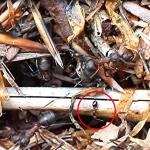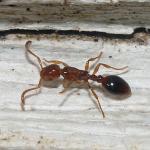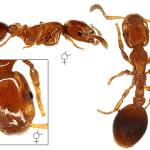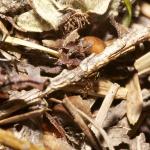This small, shining, reddish-yellow to brown ant is the only known European representative of its genus. It resembles Leptothorax and Temnothorax species, to which it is closely related. Females, and the wingless males, are worker-like in appearance, whilst individuals morphologically intermediate between females and workers also occur. Formicoxenus nitidulus is a ‘guest ant’, living only within the nest mounds of its ant hosts. These are usually ‘wood ants’ (Formica subgenus Formica sens. str.). Known hosts in Britain are F. aquilonia, F. lugubris and F. rufa. Although it obtains food from its hosts, F. nitidulus establishes discrete nests and rears its own brood. Whether or not it should be considered a true social parasite is therefore a matter of some debate. (See Dumpert (1981) and Hölldobler & Wilson (1990) for differing views, and (together with Donisthorpe (1927), Collingwood (1979), and studies cited therein) for more extensive accounts and discussion of information included in this profile.)
The scattered British records of F. nitidulus cover much of the areas of England, Wales and Scotland from which its hosts are recorded, but as yet it is unknown from Ireland and the Channel Islands. Elsewhere, F. nitidulus ranges from latitude 70°N to north Italy and from Spain to eastern Siberia.
Neither Shirt (1987) nor Falk (1991) list F. nitidulus as scarce or threatened in Britain. Apparently uncommon, it can be difficult to find, and its true status is therefore unclear. Several new localities have been found during the 1990s, suggesting that the persistently small number of records reflects some under-recording.
Although F. nitidulus seldom leaves the host mound interior, individuals may be seen on the mound surface on warm, dull, humid days. Males and winged females are present during July and August, with males persisting, perhaps exceptionally, into November (Robinson 1998). Since the males are wingless, there is no nuptial flight. Females release a male-attracting pheromone and mating takes place on the surface of a Formica mound.
Within the host nest mound, F. nitidulus nests in hollow twigs and stems, wood fragments or the earth floor. A single Formica mound may have several of these nests, each, typically, with less than 100 workers and perhaps several females, but only one egg-laying queen.
Workers forage singly, leaving their nest via narrow galleries connecting with the interior of the host mound. They obtain food from host workers, either by intercepting regurgitated food being passed between them, or by direct soliciting. Captive F. nitidulus will take Leptothorax/Temnothorax larvae, but there is no evidence that they feed on host brood.
2021





